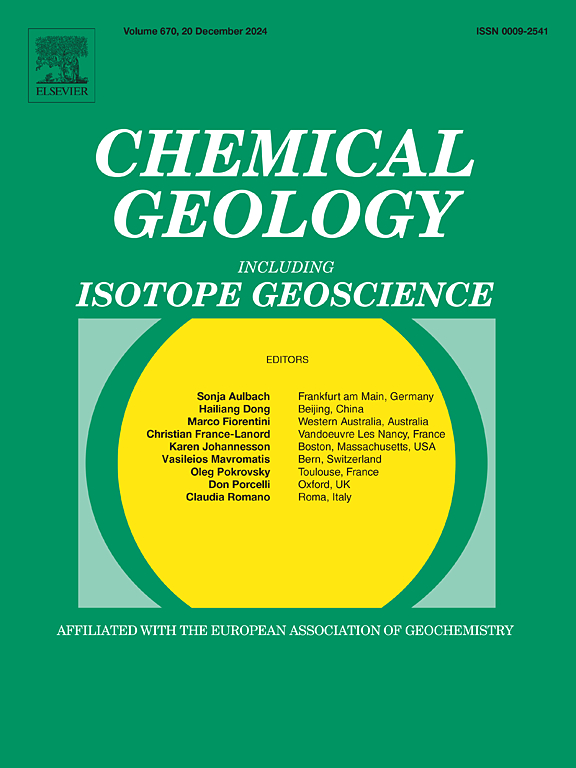Non-conservative behaviour of molybdenum in the Ganga (Hooghly) River estuary, India: Role of solute-particle interaction and sediment diagenesis
IF 3.6
2区 地球科学
Q1 GEOCHEMISTRY & GEOPHYSICS
引用次数: 0
Abstract
This study is focussed on understanding of molybdenum (Mo) cycling in the mesotidal to macrotidal estuary of the Ganga (Hooghly) River in India. Our investigation encompasses the composition of water and suspended particulate matter (SPM) samples collected in three separate periods (pre-monsoon: PrM, monsoon: M and post-monsoon: PoM) over two consecutive years, surface sediments, exchangeable phases of surface and suspended sediments, one sediment core, urban and industrial effluent waters and ground waters. The observed dissolved Mo concentrations in the estuary are in excess of those expected from conservative mixing of seawater and river water. The “excess” Mo values, observed in the mid-to-high salinity regions (4–27 ‰) for four out of the six study periods, are the highest in the monsoon samples. The bulk and exchangeable phase compositions are supportive of release of Mo from the Fe-Mn oxyhydroxide phases of the SPM and surface sediments in the estuary. Mass balance calculations indicate that Mo release from the SPM and surface sediments can account for up to 40 % of the median value of the “excess” Mo in the estuary. The compositions of the sediment core provide evidence for the mobilization of Mo and its release to porewater due to reductive dissolution of Fe-Mn oxyhydroxides. The tidally induced sediment resuspension likely facilitates the transport of porewater Mo to the overlying water. Mass balance calculations indicate that Mo loss from the sediment column can account for the bulk of the “excess” Mo in the estuary waters. This study further demonstrates that industrial effluents, urban waste waters and groundwaters do not constitute significant sources of dissolved Mo in the estuary.
The average annual Mo flux from the estuary is (∼2–3) × 106 mol, of which ∼30–50 % of Mo is due to estuarine addition. More significantly, Mo contribution from the Hooghly River estuary, accounting for ∼0.7–1.0 % of the global riverine Mo flux, is ∼3–4 folds higher than its water contribution (∼0.25 %) to the global river water flux. Our study highlights the role of interactions between oxyhydroxide phases and estuarine water, diagenetic mobilization of elements in the sediment column and porewater transport in the cycling of Mo in a monsoon-dominated tropical estuary with high sediment loads. We also demonstrate that the mobilization of Mo through chemical weathering is driven by physical weathering in the catchments of the South Asian Rivers.
印度恒河(胡格利)河口钼的非保守行为:溶质-颗粒相互作用和沉积物成岩作用
本文主要研究了印度恒河(Hooghly)河口中潮至大潮的钼(Mo)循环。我们的调查包括连续两年在三个不同时期(季风前:PrM,季风:M和季风后:PoM)收集的水和悬浮颗粒物(SPM)样本的组成,地表沉积物,地表和悬浮沉积物的交换相,一个沉积物核心,城市和工业废水和地下水。观测到的河口溶解Mo浓度超过了海水与河水保守混合的预期浓度。在6个研究期中,有4个期在中高盐度区(4 ~ 27‰)观测到的Mo“过量”值在季风样品中最高。体积相组成和交换相组成支持Mo从SPM和河口表层沉积物的Fe-Mn氢氧化物相中释放。质量平衡计算表明,SPM和表层沉积物释放的Mo最多可占河口“过量”Mo中值的40%。沉积物岩心的组成提供了Mo的动员及其释放到孔隙水中的证据,这是由于Fe-Mn氢氧化物的还原性溶解。潮汐引起的泥沙再悬浮可能促进孔隙水Mo向上覆水的输送。质量平衡计算表明,沉积物柱的Mo损失可以解释河口水域“过量”Mo的大部分。该研究进一步表明,工业废水、城市污水和地下水不是河口溶解钼的重要来源。
本文章由计算机程序翻译,如有差异,请以英文原文为准。
求助全文
约1分钟内获得全文
求助全文
来源期刊

Chemical Geology
地学-地球化学与地球物理
CiteScore
7.20
自引率
10.30%
发文量
374
审稿时长
3.6 months
期刊介绍:
Chemical Geology is an international journal that publishes original research papers on isotopic and elemental geochemistry, geochronology and cosmochemistry.
The Journal focuses on chemical processes in igneous, metamorphic, and sedimentary petrology, low- and high-temperature aqueous solutions, biogeochemistry, the environment and cosmochemistry.
Papers that are field, experimentally, or computationally based are appropriate if they are of broad international interest. The Journal generally does not publish papers that are primarily of regional or local interest, or which are primarily focused on remediation and applied geochemistry.
The Journal also welcomes innovative papers dealing with significant analytical advances that are of wide interest in the community and extend significantly beyond the scope of what would be included in the methods section of a standard research paper.
 求助内容:
求助内容: 应助结果提醒方式:
应助结果提醒方式:


